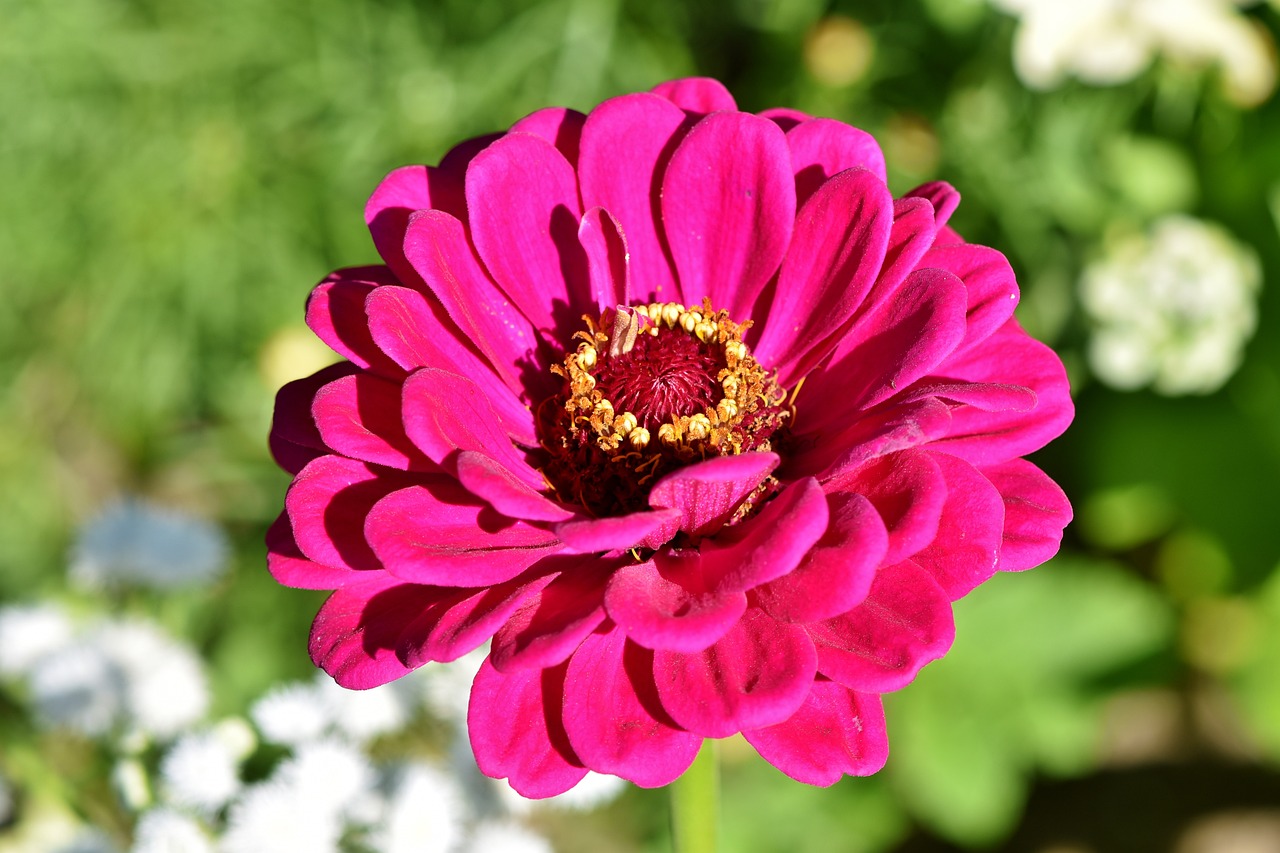The history and culture of zinnias is a fascinating topic that delves into the origins and significance of these vibrant flowers in different cultures. Zinnias have a rich history that dates back to their native regions of Mexico and South America. These flowers were first introduced to Europe in the 18th century and quickly gained popularity for their beauty and versatility.
Zinnias have played a significant role in various cultures around the world. In Mexico, they are often associated with Day of the Dead celebrations and are used to decorate altars and graves. In Victorian England, zinnias were considered a symbol of lasting affection and were frequently included in romantic bouquets. These flowers have also been featured in art and literature, with their vibrant colors and unique shapes inspiring artists and writers alike.
When it comes to gardening, zinnias are a beloved choice for many enthusiasts. They are easy to grow and come in a wide range of colors, sizes, and shapes. From the small and delicate ‘Thumbelina’ variety to the large and showy ‘Benary’s Giant’ blooms, zinnias offer endless possibilities for creating stunning garden displays.
In floral arrangements, zinnias add a pop of color and a touch of whimsy. Their bold and vibrant petals make them a popular choice for bouquets, whether used as a focal point or as part of a mixed arrangement. Zinnias can be paired with other flowers and foliage to create a variety of styles, from rustic and wildflower-inspired to modern and sophisticated.
In conclusion, the history and culture of zinnias is a testament to their enduring appeal and significance. These flowers have captivated people from different cultures and have made a lasting impact on gardening and floral arrangements. Whether you’re a gardener or a flower enthusiast, zinnias are sure to bring joy and beauty to any space.
Origins of Zinnias
The origins of zinnias can be traced back to their native regions in Mexico and South America. These vibrant flowers were first discovered by Spanish explorers in the 16th century during their expeditions to the New World. Zinnias were then brought back to Europe and quickly gained popularity among garden enthusiasts. Their unique beauty and vibrant colors captivated the hearts of people across different continents.
Zinnias were introduced to various parts of the world, including North America, Asia, and Africa, where they adapted to different climates and flourished. Today, zinnias are widely cultivated and cherished for their ability to thrive in diverse environments. Their journey from their native regions to different corners of the globe is a testament to their resilience and the universal appeal of their striking blooms.
Cultural Significance of Zinnias
The cultural significance of zinnias is deeply rooted in various societies, where they hold symbolic meanings and play significant roles in art, literature, and religious rituals. These vibrant flowers have captured the imagination of people across different cultures, becoming a source of inspiration and admiration.
In art, zinnias are often depicted in paintings and sculptures, symbolizing beauty, creativity, and the fleeting nature of life. Their vibrant colors and delicate petals make them a popular subject for artists seeking to capture the essence of nature’s beauty. Zinnias have also found their way into literature, where they are often used as metaphors for love, passion, and the complexities of human emotions.
Furthermore, zinnias have played important roles in religious rituals and ceremonies. In some cultures, they are offered as sacred flowers during religious festivals and used to decorate altars and shrines. The vivid hues of zinnias are believed to represent spiritual enlightenment and divine blessings.
The cultural significance of zinnias extends beyond their visual appeal. They have become powerful symbols that evoke emotions, convey messages, and connect people to nature and spirituality. Whether adorning a painting, adorning a religious space, or inspiring a poet’s words, zinnias continue to captivate hearts and minds across different cultures.
Zinnias in Gardening
Zinnias have become increasingly popular in gardening due to their vibrant colors, easy cultivation, and versatility. With over 20 species and numerous cultivars, zinnias offer a wide range of options for gardeners to choose from. These flowers come in various sizes, shapes, and colors, including red, pink, orange, yellow, and white, making them a delightful addition to any garden.
When it comes to cultivating zinnias, they are relatively low-maintenance plants that can thrive in different climates. They prefer well-drained soil and full sun exposure, but they can tolerate a variety of soil conditions. Zinnias are typically grown from seeds, which can be sown directly into the ground or started indoors and transplanted. Regular watering and occasional fertilization are usually sufficient to keep zinnias healthy and blooming throughout the growing season.
- Zinnias are popular in gardening due to their vibrant colors and versatility.
- There are over 20 species and numerous cultivars of zinnias to choose from.
- Zinnias come in various sizes, shapes, and colors, adding charm to any garden.
- They are relatively low-maintenance plants that can thrive in different climates.
- Zinnias prefer well-drained soil and full sun exposure but can tolerate various conditions.
- They are usually grown from seeds, which can be sown directly or started indoors.
- Regular watering and occasional fertilization are essential for their health and blooming.
Whether you have a small backyard garden or a large landscape, zinnias can be a fantastic choice to bring vibrant colors and beauty to your outdoor space. Their ability to attract butterflies and bees also makes them beneficial for pollinators. With their popularity in gardening continuing to grow, zinnias have undoubtedly earned their place as a beloved flower among garden enthusiasts.
Zinnias in Floral Arrangements
Zinnias are widely recognized for their aesthetic appeal in floral arrangements. These vibrant flowers come in a variety of colors, from bold reds and oranges to soft pinks and purples, making them a versatile choice for different designs. Whether used as the focal point or as a complementary element, zinnias add a pop of color and a touch of elegance to any flower display.
One of the reasons zinnias are highly valued in floral arrangements is their versatility. They can be incorporated into various styles, from traditional bouquets to modern and abstract designs. Their long stems make them suitable for tall arrangements, while their smaller blooms can be used in compact and intricate designs. Zinnias can also be combined with other flowers and foliage to create stunning and visually appealing compositions.
When it comes to incorporating zinnias into floral displays, the possibilities are endless. They can be used in arrangements for weddings, birthdays, anniversaries, or any other special occasion. Zinnias can be arranged in vases, baskets, or even as part of larger installations. Their vibrant colors and unique shapes make them stand out and create a captivating visual impact.
In conclusion, zinnias offer an aesthetic appeal that is hard to resist in floral arrangements. Their versatility allows for creativity and experimentation in various designs, while their vibrant colors add vibrancy and charm to any flower display. Whether used as the star of the show or as a supporting element, zinnias are sure to enhance the beauty and elegance of any floral arrangement.
Frequently Asked Questions
- What are the different varieties of zinnias available for gardening?
There are numerous varieties of zinnias that you can choose from for your garden. Some popular ones include the California Giant, Thumbelina, and Profusion series. Each variety offers unique colors, sizes, and growth habits, allowing you to create a vibrant and diverse zinnia garden.
- How do I care for zinnias in different climates?
Zinnias are known for their adaptability to various climates. In hot and dry regions, make sure to provide them with ample water and provide some shade during the hottest parts of the day. In cooler climates, it’s essential to plant them after the last frost and ensure they receive enough sunlight. Regular deadheading and fertilizing will also help promote healthy growth.
- Can zinnias be used in different styles of floral arrangements?
Absolutely! Zinnias are incredibly versatile and can be incorporated into various floral arrangements. Their vibrant colors and sturdy stems make them suitable for both formal and informal designs. Whether you’re creating a classic bouquet or a modern centerpiece, zinnias can add a pop of color and a touch of elegance to any arrangement.
- What do zinnias symbolize in different cultures?
Zinnias carry different symbolic meanings across cultures. In some societies, they represent endurance and remembrance, making them a popular choice for memorial gardens. In other cultures, they symbolize friendship and lasting affection. Regardless of the cultural interpretation, zinnias are universally loved for their beauty and ability to brighten up any space.


